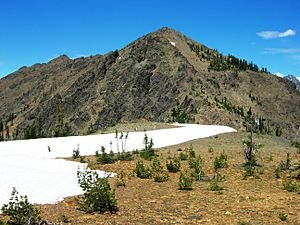Teanaway Peak facts for kids
Quick facts for kids Teanaway Peak |
|
|---|---|
| Genes Peak | |

South aspect, from Iron Peak
|
|
| Highest point | |
| Elevation | 6,779 ft (2,066 m) |
| Prominence | 539 ft (164 m) |
| Isolation | 0.72 mi (1.16 km) |
| Parent peak | Bills Peak (6,917 ft) |
| Geography | |
| Location | Kittitas County / Chelan County Washington, U.S. |
| Parent range | Wenatchee Mountains Cascade Range |
| Topo map | USGS Mount Stuart |
| Type of rock | Serpentinite |
| Climbing | |
| Easiest route | class 2 scrambling |
Teanaway Peak is a tall mountain in Washington state. It stands about 6,779 feet (2,066 meters) high. This peak is located in the Wenatchee Mountains, right on the border between Kittitas County and Chelan County.
Teanaway Peak is part of the beautiful Alpine Lakes Wilderness area. The land around it is managed by the Wenatchee National Forest. The closest taller mountain is Bills Peak, which is about 0.72 miles (1.16 kilometers) to the east. Rain and melting snow from Teanaway Peak flow into two different river systems. Some water goes south into the Teanaway River, and some goes north into Turnpike Creek, which is part of the Wenatchee River.
If you climb to the top of Teanaway Peak, you get amazing views of Mount Stuart and the Stuart Range. This mountain is also known as "Genes Peak." It was named after Gene Prater (1929–1993). Gene was the younger brother of Bill Prater, who Bills Peak is named after. Gene Prater helped invent the modern aluminum snowshoe. He also wrote a famous book called "Snowshoeing: From Novice to Master." Gene was also the first person to climb several other peaks, including Sherpa Peak and the east summit of Ingalls Peak.
Weather at Teanaway Peak
The area around Teanaway Peak is east of the Cascade Range. This means it's a bit drier than places to the west. In summer, it can get warm, and sometimes there are thunderstorms.
Most weather systems come from the Pacific Ocean. They travel east towards the Cascade Range. When these weather systems reach the tall Cascade Mountains, they are forced to rise. As they go up, they drop their moisture as rain or snow onto the western slopes of the Cascades. This process is called Orographic lift. Because of this, the eastern slopes of the Cascades, where Teanaway Peak is, get less rain and snow than the western slopes.
During winter, the weather is usually cloudy. But in summer, high-pressure systems over the Pacific Ocean often bring clear skies. This means there's usually little or no cloud cover during the warmer months.
How Teanaway Peak Was Formed
The Alpine Lakes Wilderness has some very rugged land. You can see jagged peaks, sharp ridges, deep valleys carved by glaciers, and tall granite walls. There are also more than 700 mountain lakes in this area.
Millions of years ago, big geological events created the varied landscape and huge changes in elevation across the Cascade Range. These changes also led to the different climates we see today.
The Cascade Mountains started forming millions of years ago, during the late Eocene Epoch. At that time, the North American Plate was slowly moving over the Pacific Plate. This movement caused many volcanic eruptions and created new rocks. Also, small pieces of the Earth's crust, called terranes, joined together to form the North Cascades about 50 million years ago.
Over two million years ago, during the Pleistocene period, huge sheets of ice called glaciers moved across the land many times. These glaciers carved and shaped the landscape. The last glaciers in the Alpine Lakes area started to melt and move north about 14,000 years ago. They had crossed into Canada by 10,000 years ago. The river valleys in this area have a "U" shape. This shape was created by those recent glaciers.
The lifting of the land (called uplift) and cracks in the Earth's crust (called faulting) worked with the glaciers. Together, these processes created the tall peaks and deep valleys you see in the Alpine Lakes Wilderness today.




